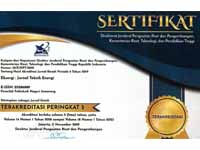The Effectiveness of Mechanical Power on An Auxiliary Rotor in The Design of Counter Rotating Wind Turbine (CRWT)
DOI:
https://doi.org/10.32497/eksergi.v21i01.6359Keywords:
Wind turbine, horizontal axis, double rotor, counter rotationAbstract
The counter-rotating wind turbine (CRWT) represents a novel development in horizontal-axis wind turbine technology. This innovative design incorporates an additional rotor that rotates in unison with the main rotor along the same axis. Without the supplementary rotor, the turbine's configuration is analogous to that of a horizontal-axis wind turbine (HAWT) with the main rotor functioning independently. The primary objective of this study is to undertake a comparative analysis of the effectiveness of mechanical energy generation, as measured by torque, between the CRWT and HAWT designs. The configuration of the wind turbine is situated within a wind tunnel, characterized by a rectangular cross-section. The testing of wind turbines has been conducted at wind velocity of 2 m/s, 3 m/s, and 4.5 m/s. The total mechanical power measured was 0.14 W, 0.21 W, and 0.28 W at wind velocity of 2 m/s, 3 m/s, and 4.5 m/s, respectively. The final results of the study have analyzed the effectiveness of power enhancement through power coefficients.
References
N.A. Pambudi, D.K. Ulfa, I.R. Nanda, I.M. Gandidi, A. Wiyono, M.K. Biddinika, B. Rudiyanto and L.H. Saw, “The Future of Wind Power Plants in Indonesia: Potential, Challenges, and Policies”. Sustainability (Switzerland), 2025, Vol. 17, pp. 1312.
W. Xu, L, Sen, S. Peng and Y. Zhou, “Aerodynamics of a three-dimensionally deformed rigid wing”, International Journal of Heat and Fluid Flow, 2024, Vol. 110, pp. 109577.
R. Bontempo and M. Manna, “Optimum design of contra-rotating wind turbines with adjacent rotors”, Energy Conversion and Management, 2025, Vol. 324, pp. 119267.
R. Mansour, S. Osama, H. Ahmed, M. Nasser, N. Mahmoud, A. Elkodama, and A. Ismaiel, “Parametric Analysis Towards the Design of Micro-Scale Wind Turbines: A Machine Learning Approach”, Applied System Innovation, 2024, Vol.7, pp. 129.
A.R. Pratama, Analisis Peningkatan Daya Pada Dual Rotor Turbin
Angin Counter Rotating dengan Variasi Perbandingan Diameter Rotor
Depan dan Rotor Belakang, Tugas Akhir Teknik Mesin dan Industri,
UGM, Yogyakarta, 2015.
M.A. Bramantya and L.A. Huda, “An experimental study on the mechanics power of counter-rotating wind turbines model related with axial distance between two rotors”, 6th International Annual Engineering Seminar, InAES 2016, 2016, pp. 212-217.
X. Shen, X. Li, F. Yin, Z. Huang, Z. Ye, and X. Guo, “The influence of the rotor spacing distance and rotating speed ratio on the power production of dual rotor wind turbines using a modified two-way interaction blade element momentum method”, Energy, 2024, Vol. 311, pp. 133274.
Y.H. Irawan and M.A. Bramantya, “Numerical simulation of the effect of axial distance between two rotors in counter-rotating wind turbines”, 2nd International Conference on Science and Technology-Computer, ICST 2016, 2017, pp. 1-5.
J.C. Jauregui-Correa and J.A. Franco Pina, Design Process for Scaled Model Wind Turbines Using Field Measurements, Journal of Fluids Engineering, 2025, Vol. 147, pp. 031107.
M.A. Habib, A.A. Jadallah and A.A. Husein, “Design and performance analysis of a counterrotating multi-rotor wind turbine - Experimental study”. 4th Scientific Conference for Electrical Engineering Techniques Research, EETR 2022, 2023, Vol. 2804, Pp. 050026.
Z.Y. Wu, H. Yan, L.C. Zhao, G. Yan, A. Chen and W.M. Zhang, Modal characteristics of a flexible dual-rotor coupling system with blade crack, Journal of Sound and Vibration, 2023, Vol. 567, pp. 118061.
E.J. Aju, P. Gong, D. Kumar, M.A. Rotea, and Y. Jin, “Power output fluctuations and unsteady aerodynamic loads of a scaled wind turbine subjected to periodically oscillating wind environments”. Journal of Renewable and Sustainable Energy, 2024., Vol. 16, pp. 053301.
H. Zhang, X. Zhai, J. Zhang, X. Bai, and Z. Li, “Mechanism Analysis of the Effect of the Equivalent Proportional Coefficient of Inertia Control for a Doubly Fed Wind Generator on Frequency Stability in Extreme Environments”, Sustainability (Switzerland), 2024, Vol.16, pp.4965.
J. Liew, K.S. Heck, “Unified momentum model for rotor aerodynamics across operating regimes”, Natural Communications, 2024, Vol. 15, pp. 6658.
Z. Lyu, Y. Li, M. Zheng, Q. Li, Y. Hu, “A rotational speed recovery strategy for wind turbines considering secondary fre⁃ quency drops”, Zhejiang Electric Power, 2024, Vol. 43, 26-35.
M.K. Chaudary and S. Prakash, “Optimizations of small horizontal-axis wind turbine rotors at low Reynolds number”, AIP Conference Proceeding, 3rd International Conference on Frontiers in Automobile and Mechanical Engineering, FAME 2020, Vol. 2311, pp. 030003.
Downloads
Published
Issue
Section
License
Copyright (c) 2025 Luqman Al Huda, Bah Evan, Ari Prasetya, Dianisa Khoirum Sandi, Eri Prihatmini, Amrisal Kamal Fajri

This work is licensed under a Creative Commons Attribution 4.0 International License.
Authors who publish with this journal agree to the following terms:Authors retain copyright and grant the journal right of first publication with the work simultaneously licensed under a Creative Commons Attribution License that allows others to share the work with an acknowledgement of the work's authorship and initial publication in this journal.
Authors are able to enter into separate, additional contractual arrangements for the non-exclusive distribution of the journal's published version of the work (e.g., post it to an institutional repository or publish it in a book), with an acknowledgement of its initial publication in this journal.
Authors are permitted and encouraged to post their work online (e.g., in institutional repositories or on their website) prior to and during the submission process, as it can lead to productive exchanges, as well as earlier and greater citation of published work (See The Effect of Open Access).






